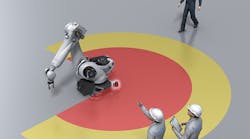The Safe Robotics Area Protection (SRAP) system from SICK provides process-based protection for workers in collaborative robotics operation. The safety system gives machine operators unrestricted, yet safe, access to a robot’s working area at any time, by adapting the operating conditions to the position of the person. These adaptive perception capabilities prevent the risk of accidents from occurring and simultaneously improve productivity.
The SRAP reduces downtime and optimizes the ergonomic and process aspects of the operator’s workflow. It system consists of a Flexi Soft safety controller and a safety laser scanner – either the space-saving S300 Mini Remote for shorter scanning ranges or the microScan3 Core for larger monitoring fields.
Safe Robotics Area Protection satisfies the criteria of Performance Level PL d in accordance with EN ISO 13849-1.
SRAP is a ready-to-use turnkey solution with prefabricated and tested software function blocks. It can be integrated easily and fits seamlessly into the controllers of all standard industrial robots.
The migration capabilities of the system configuration, plus the option of adapting it in line with additional safety functions, make Safe Robotics Area Protection a future-proof safety system that enables flexible, autonomous machines and robots to adapt quickly and effortlessly to new production conditions, safety requirements, and protective field conditions that result from this.
Depending on how close a person is to the robot, the sensors cause the robot to either reduce or stop movement via the Flexi Soft safety controller – so that work pieces can be inserted or removed, for example. If the person then leaves the monitored area, the safety system automatically starts performing sequence monitoring.
Provided that this monitoring satisfies the requirements for operating the robot safely, the robot is first started up at a reduced speed and then returns to its original working speed once all the warning and protective fields are free again. This means that the worker remains constantly protected against hazardous movements whenever they enter the robot’s working area.
At the same time, the automated restart reduces downtime once a worker leaves the hazardous area, and also optimizes the worker’s processes – laying the foundations for machines and industrial robots to be more productive.
Learn more at www.sickusa.com










